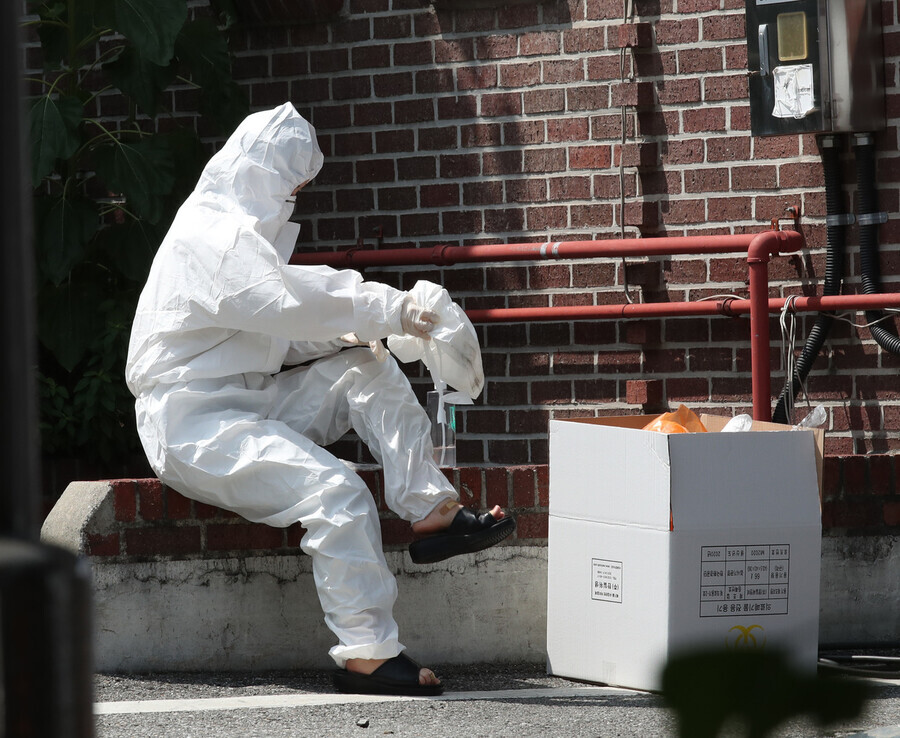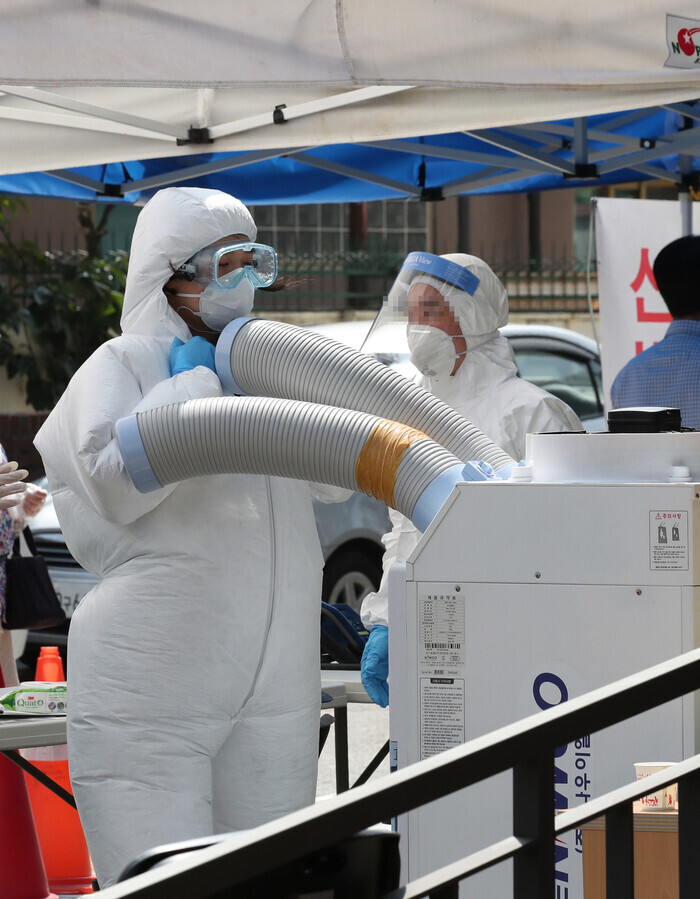hankyoreh
Links to other country sites 다른 나라 사이트 링크
[Reportage] S. Korean health workers strain under massive increase in testing

As Korea faces a second wave of COVID-19 in the Seoul Capital Area (SCA), anxiety is growing at screening centers around the country, which represent the first line of defense against the disease. The number of people tested for COVID-19 around the country more than doubled between Aug. 18 and 19, rising from 8,572 to 18,022.
“This is a moment of grave and critical danger, in which the surge of infections in Greater Seoul Area could spread around the country,” said Vice Health Minister Kim Kang-lip, deputy director of the Central Disease Control Headquarters, during the daily briefing on Aug. 19, when the country saw nearly 300 new cases. The caseload for Aug. 20 was 276.
Considering that the results of one day’s tests are reflected in the number of new cases reported the following day, the daily caseload may increase on Aug. 21 and on subsequent days.
At 11 am on Aug. 18, as newly confirmed cases of COVID-19 remained in the triple digits for the fifth consecutive day, a line of people in masks extended for about 50m in front of a screening center at the public health center in Seoul’s Jongno District. That morning alone, 160 people visited the district’s screening center.
Anxiety was palpable among those standing in line. People seemed desperate to get tested for the disease. With worried eyes, they adjusted their face masks even as sweat dribbled down under the midday sun. The health center employees carrying out the tests were sweating even more under their protective gear. People appear to have regained the alertness that had flagged during recent months. At least at the screening center, fatigue over the protracted battle with the disease felt like a luxury.
The screening center in Jongno District was bustling because of its location at the center of a new wave of infections in the capital, with visitors worried by an Aug. 15 rally near Gwanghwamun Square that brought in people from around the country. “There’s been a sharp increase in office workers and residents near Gwanghwamun Square coming by to be tested since Aug. 15 because of their anxiety over the spread of COVID-19,” a health center staffer said.
I myself had dropped by the public health center to get tested, the day after covering a press conference in front of Sarang Jeil Church in Seoul’s Seongbuk District on Aug. 17. I took a number when I arrived at 11 am but had to wait four hours, until 3:20 pm, for the actual test.

When the line showed no signs of slowing after 2 pm, a staffer at the health center had to send away late arrivals. The center tested 247 people on Wednesday alone. Staff said that only 50 or so people were getting tested each day between Aug. 12 and 16, but the number jumped to the triple digits on Aug. 17, after the rally.
Public health centers in other districts of Seoul have also been swamped. When the Hankyoreh surveyed how many people were being tested at public health centers in eight districts, it found that numbers had risen by a factor of between three and 10 from Aug. 13, when there were only 20 or so new cases in the SCA, and Aug. 18.
The rapid climb appears to have begun after Aug. 12, when the first cases were diagnosed at Sarang Jeil Church. The number of people tested at a screening center in Seongbuk District, where the church is located, rose from 86 on Aug. 13 to 260 on Aug. 18, while the number tested in neighboring Gangbuk District rose from 43 to 423 over the same period.
“The medical workers at screening centers are already exhausted because they’ve been working without any days off as the COVID-19 pandemic drags on. The recent spike in the number of people being tested has made things even harder for them,” said an official at one of Seoul’s districts. A similar situation is in place at Seoul’s general hospitals, which have seen their testing workload nearly triple compared to last month.
Given the inconvenience caused by the steep increase in people getting tested, the Seoul Metropolitan Government said it would extend the hours of operations at public health centers in Seongbuk and Jungnang Districts, which are seeing a high demand for testing. If necessary, the city will also set up more temporary screening stations.
By Kang Jae-gu and Lee Jae-ho, staff reporters
Please direct comments or questions to [english@hani.co.kr]

Editorial・opinion
![[Editorial] Intensifying US-China rivalry means Seoul must address uncertainty with Beijing sooner than later [Editorial] Intensifying US-China rivalry means Seoul must address uncertainty with Beijing sooner than later](https://flexible.img.hani.co.kr/flexible/normal/500/300/imgdb/original/2024/0517/8117159322045222.jpg) [Editorial] Intensifying US-China rivalry means Seoul must address uncertainty with Beijing sooner than later
[Editorial] Intensifying US-China rivalry means Seoul must address uncertainty with Beijing sooner than later![[Column] When ‘fairness’ means hate and violence [Column] When ‘fairness’ means hate and violence](https://flexible.img.hani.co.kr/flexible/normal/500/300/imgdb/original/2024/0516/7417158465908824.jpg) [Column] When ‘fairness’ means hate and violence
[Column] When ‘fairness’ means hate and violence- [Editorial] Yoon must stop abusing authority to shield himself from investigation
- [Column] US troop withdrawal from Korea could be the Acheson Line all over
- [Column] How to win back readers who’ve turned to YouTube for news
- [Column] Welcome to the president’s pity party
- [Editorial] Korea must respond firmly to Japan’s attempt to usurp Line
- [Editorial] Transfers of prosecutors investigating Korea’s first lady send chilling message
- [Column] Will Seoul’s ties with Moscow really recover on their own?
- [Column] Samsung’s ‘lost decade’ and Lee Jae-yong’s mismatched chopsticks
Most viewed articles
- 1Celine Song says she’s gratified global audiences have responded to the kismet of ‘inyeon’
- 2[Editorial] Transfers of prosecutors investigating Korea’s first lady send chilling message
- 3[Exclusive] Unearthed memo suggests Gwangju Uprising missing may have been cremated
- 4[Column] US troop withdrawal from Korea could be the Acheson Line all over
- 5Xi, Putin ‘oppose acts of military intimidation’ against N. Korea by US in joint statement
- 6Truth commission confirms Korean War killings by soldiers and police
- 7USFK sprayed defoliant from 1955 to 1995, new testimony suggests
- 8[Editorial] South Korean women are mobilizing in unprecedented ways
- 9Calls for gender-equality continue as demonstrations target President Moon
- 10[Column] “Hoesik” as ritual of hierarchical obedience